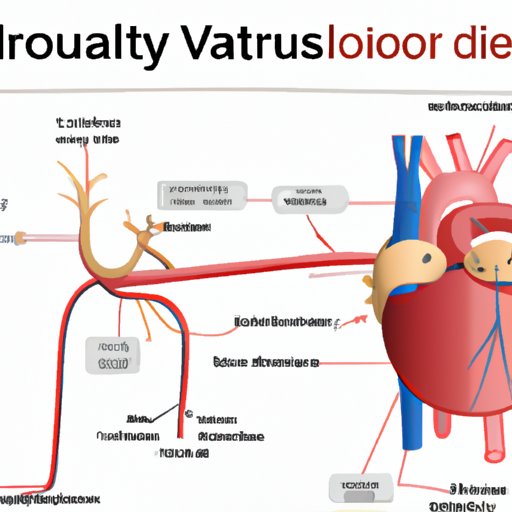Introduction
The human body is an incredible machine, composed of many different and interconnected systems. The nervous system and the circulatory system are two of the most important and complex systems within the body. Understanding how they work together can help us better understand the intricate workings of the human body.
The nervous system is responsible for controlling and coordinating all activities of the body. It consists of the brain, spinal cord, and a network of nerves that allow us to sense the environment around us, respond to external stimuli, and control our movements. The circulatory system is responsible for transporting oxygen, nutrients, and hormones throughout the body. It consists of the heart, arteries, veins, and capillaries.
Both the nervous and circulatory systems are essential for life, and they are intricately connected. In this article, we will explore how the nervous system and circulatory system work together to keep the body functioning properly.
How the Nervous System and Circulatory System Work Together
The nervous system and circulatory system interact in a number of ways. Neurons, or nerve cells, send electrical signals throughout the body. These signals can stimulate muscle contractions, which in turn can influence blood flow and pressure. For example, when we exercise, our muscles contract and our heart rate increases as a result of nerve impulses sent from the brain.
Nerve impulses can also cause vasoconstriction, which is the narrowing of the blood vessels. This can increase blood pressure because it reduces the amount of blood flowing through the vessels. On the other hand, nerve impulses can also cause vasodilation, which is the widening of the blood vessels. This has the opposite effect, decreasing blood pressure.
In addition to influencing blood flow and pressure directly, the nervous system also plays an important role in regulating the body’s internal environment. This is done through the autonomic nervous system, which is responsible for regulating unconscious activities such as heart rate, digestion, and respiration.
The autonomic nervous system is divided into two parts: the sympathetic nervous system and the parasympathetic nervous system. The sympathetic nervous system is responsible for activating the body’s “fight or flight” response in stressful situations. This response causes an increase in heart rate and blood pressure. On the other hand, the parasympathetic nervous system is responsible for calming the body down and restoring balance. It causes a decrease in heart rate and blood pressure.
The central nervous system (CNS) also plays an important role in regulating the body’s internal environment. The CNS consists of the brain and spinal cord, and it is responsible for higher-level functions such as thought, emotion, and memory. The CNS sends signals to the autonomic nervous system to regulate the body’s internal environment. For example, when we feel anxious, the CNS sends signals to the sympathetic nervous system to activate the “fight or flight” response.

Understanding the Link Between the Nervous and Circulatory Systems
The nervous system and circulatory system are closely linked and their interaction is essential for maintaining homeostasis. The autonomic nervous system plays a key role in regulating blood pressure. When the sympathetic nervous system is activated, it causes an increase in heart rate and blood pressure. On the other hand, when the parasympathetic nervous system is activated, it causes a decrease in heart rate and blood pressure.
The central nervous system also influences the body’s internal environment. It sends signals to the autonomic nervous system to regulate blood pressure and heart rate. In addition, the CNS can also influence blood flow and pressure directly. For example, when we become frightened, the CNS sends signals to the muscles of the body, causing them to contract. This contraction can reduce blood flow and increase blood pressure.
Conclusion
The nervous system and circulatory system are closely connected and work together to maintain homeostasis. Neurons and nerve impulses can influence blood flow and pressure directly, while the autonomic and central nervous systems play a key role in regulating blood pressure. By understanding how these two systems interact, we can gain a deeper appreciation for the complexity and interconnectedness of the human body.
(Note: Is this article not meeting your expectations? Do you have knowledge or insights to share? Unlock new opportunities and expand your reach by joining our authors team. Click Registration to join us and share your expertise with our readers.)
